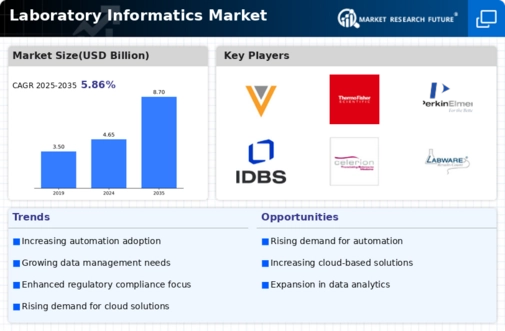Market Analysis
In-depth Analysis of Laboratory Informatics Market Industry Landscape
Laboratory informatics is a field of computer science that is expanding quickly and helps labs in many different types of industries work better by making tasks easier. To help labs handle and improve their data, methods, and operations, there is software and tools on the market. It's getting harder to do things in the lab, and we need good data. This means that data from the lab needs to be put into computers. In labs, modern software is used to collect data, process it, and make reports. More work gets done and mistakes happen less often because of this. There is more and more use of AI and ML in lab computer products, which is good for the market growth. These technologies make it faster to handle data, which gives us new information and tools for making predictions that help us make choices. The cloud is becoming a better place to store more and more lab software. Labs can see and change data from afar with these tools. These changes happen because cloud solutions are flexible, large, and cheap. They make it simple for teams in various places to share information and talk to each other. Lab work in the drug and health care industries has to follow rules set by the government. Even more so in the drug business. This need is driving the laboratory informatics market to deliver solutions that meet regulatory, data integrity, and security criteria. Laboratory informatics solutions for specific businesses are becoming more popular. Biological sciences, environmental science, and food and beverage sectors have different data handling and analytic needs. Vendors are developing sector-specific solutions. Laboratory firms are expanding globally. Globalization has increased the demand for laboratory informatics systems that enable data and collaboration across borders, encouraging efficient communication and resource utilization. When building laboratory informatics systems, user experience is crucial. Vendors are focusing on user-friendly interfaces to make software easy for lab workers of all technical levels to utilize. Mobile applications allow users to access and manage data from numerous places, making them popular in laboratory informatics. This product meets the rising requirement for real-time data monitoring and decision-making, allowing laboratory staff to stay connected regardless of location. Due to mergers and deals, the market for laboratory computing is getting smaller. Bigger companies are buying up smaller businesses that specialize in certain areas so that they can give more products and have a stronger place in the market. This trend makes the business more mature and competitive. Despite the growing demand for advanced laboratory informatics solutions, many firms still struggle with cost and budget. To address laboratories' budgetary concerns, suppliers are offering scalable systems and flexible pricing. Laboratory informatics is poised to grow due to the global digital revolution in laboratories. Technology is expected to improve data analytics, interoperability, and laboratory efficiency in the sector.









Leave a Comment